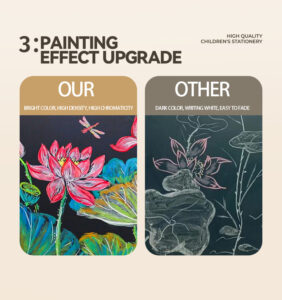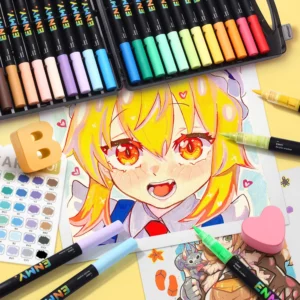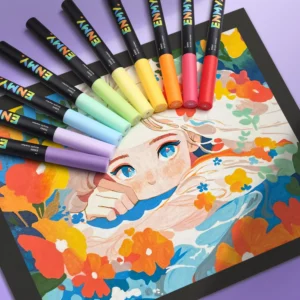When we stand before the Mona Lisa gazing at that mysterious smile, or get swept up in the swirling starry sky of Van Gogh’s The Starry Night, we can’t help but be moved by the magic of the paintings. The charm of these timeless works stems not only from the artists’ emotions and thoughts but also from the meticulously honed painting techniques — they are like words to a writer, the unique language with which artists tell about the world.
The Cornerstone of Painting Techniques: The Dialogue Between Lines and Forms
Lines are the oldest means of expression in painting. As early as in the cave paintings of the Paleolithic era, primitive people used ochre to outline the contours of running bison. The magic of lines lies in their infinite expressiveness: Da Vinci used precise straight lines to construct human proportions in Vitruvian Man, endowing the painting with scientific rigor; while Picasso’s Guernica used twisted and fragmented curves to cry out against the cruelty of war.
In Eastern painting, lines hold an even more special position. When Wu Daozi painted figures, his brushstrokes swirled like “water shield strips”, and the sleeves fluttered as if “Wu’s ribbons dancing in the wind”. With just the density, thickness, and speed of the lines, he could create a sense of three – dimensionality and vitality. This “form – shaping with lines” technique, in sharp contrast to the “chiaroscuro” popular during the Western Renaissance, can also reach the core of art.
The shaping of forms is an extension of lines. When lines close, basic shapes are formed, and artists use techniques such as exaggeration, deformation, and simplification to make forms the carriers of emotions. Matisse’s The Dance simplifies the human body into twisting arcs, conveying the ecstasy of life with the purest forms; while Michelangelo, in the Sistine Chapel ceiling paintings, uses the muscular and tense human forms to praise the nobility of divinity and humanity.

The Symphony of Colors: From Realism to Symbolism
Color is the most appealing element in painting, and the techniques of using color reflect the artists’ way of perceiving the world. The masters of classical oil painting invented the “glazing technique”. By 叠加 multiple layers of transparent pigments, they made the colors as 温润 and rich as gemstones. In Rembrandt’s portraits, the faces are illuminated by a beam of golden light, while the surroundings are immersed in deep shadows. This “chiaroscuro” technique not only enhances the dramatic tension of the painting but also gives the colors a rhythmic, breathing quality.
Impressionist painters subverted traditional color concepts. Monet, in his Haystacks series, captured the changing light at different times and discovered that shadows are not simply black but full of reflections of environmental colors. They abandoned the brownish – black treatment of dark areas and instead used more pure complementary colors placed side by side — such as purple next to yellow — to create a stronger visual vibration of colors. This “optical mixing” technique completely changed the color system of Western painting.
When colors break away from the imitation of nature, they are elevated to a symbolic language. Van Gogh used swirling yellow vortexes to express the fanaticism of the starry sky, Munch used a blood – red sky to depict the despair in The Scream, and Kandinsky believed that “red is the blare of a trumpet, blue is the depth of a cello”, directly linking colors to the emotions of music. At this point, color techniques have become a direct projection of the artist’s inner world.
The Magic of Light and Shadow: Shaping Space and Texture
Light and shadow are crucial for painting to create a sense of space. In the era without photography, painters used light and shadow techniques to make two – dimensional canvases produce a three – dimensional illusion. In The Last Supper, Da Vinci directed all the light focus to Christ’s head, not only highlighting the main subject but also, through the perspective of light and shadow, giving the room a sense of depth extending inward. The combination of this “linear perspective” and light and shadow is one of the greatest artistic inventions of the Renaissance.
Different light and shadow techniques can create completely different atmospheres. Caravaggio was good at the “cellar light” technique, letting light stream into a dark room through a small window, illuminating some objects while the rest are hidden in shadows, making the painting full of mystery and tension; while Vermeer’s Girl with a Pearl Earring used soft diffused light to outline the girl’s profile, and the pearl earring glowed with a subtle luster in the light and shadow, freezing an ordinary moment into eternal poetry.
For the expression of texture, light and shadow techniques are even more indispensable. When Rembrandt painted metal utensils, he would deliberately retain the “highlight” — that small patch of unblended pure white, which immediately gives the cold metal a reflective texture; while the painters of the Dutch Golden Age used delicate brushstrokes to depict the texture of fabrics, and then strengthened the folds with the light and shadow changes, making viewers almost able to feel the softness and thickness of the tablecloth.
The Warmth of Brushstrokes: The Artist’s “Fingerprint”
Brushstrokes are the most personal technique in painting, like an artist’s fingerprint, revealing the emotions and state during creation. Van Gogh’s brushstrokes are wild short lines, full of explosive power like burning flames, with each stroke carrying his neurotic passion; while Ingres’ brushstrokes are as delicate as silk. In The Source, the girl’s skin is polished to have no trace of brushstrokes, as if carved from marble, embodying the ultimate pursuit of classicism.
The thickness of brushstrokes can also produce different effects. The “impasto” technique piles up pigments on the canvas to create texture. When Monet painted water lilies, he used a palette knife to scrape the pigments to create the ripples of the water surface. When viewed up close, they are just chaotic color blocks, but when stepping back a few steps, one can feel the shimmering rhythm of the water. The “wet – on – wet” technique, on the other hand, allows for quick blending while the pigments are still wet. Qi Baishi painted shrimps by dotting their bodies with light ink while it was wet, and the naturally formed ink color changes are just like the translucent texture of shrimp shells.
In modern painting, brushstrokes have even become an independent object of expression. Pollock’s “drip painting” completely abandoned the brush, dripping and splashing pigments freely on the canvas. Those intertwined lines record the trajectory of his body movements, and at this point, the brushstrokes themselves are the entire content of the art.
From the naive lines of cave paintings to the diverse experiments of contemporary art, the evolution of painting techniques is also the evolution of human perception of the world and expression of oneself. When we understand the logic behind these techniques, when we look at a painting again, we are no longer passive viewers — we can read the emotions in the brushstrokes, hear the symphony of colors, and finally have a dialogue with the artist across time and space. After all, the magic of painting has never been just about “what is painted”, but more about those exquisite moments of “how to paint”.






